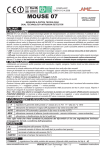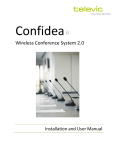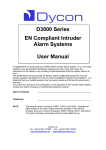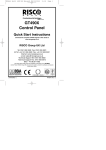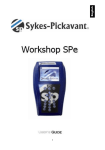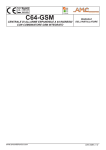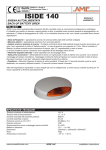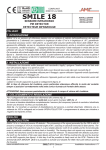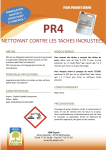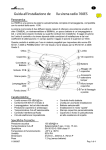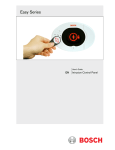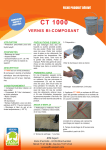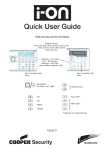Download CT 1000 - Monacor
Transcript
EN50131-1 Grade 2 PD6662 Grade 2 Environmental Class 2 CT 1000 PSTN SPEECH DIALLER USER MANUAL ENGLISH DESCRIPTION CT 1000 is a PSTN speech dialler that is able to send SPEECH and CONTACT-ID digital protocol. The device can be completely remote controlled by voice prompt that guides the user step by step throughout all the operation to be done. The system can be programmed through the integrated keypad or by PC software. Further the normal PSTN speech dialler functions, it’s possible to use it like vocal memorandum, alarm clock, or like answering service. It’s provided by a multiuser menù that allows to arm and disarm the device, visualize all the events, reset the call cycle, change all the telephone numbers, listen and record local or remote messages, activate and deactivate controls through some codes. CT1000, besides being a dialler, can be used like a small alarm control unit. It can manage: - 8 user codes, - snapshot and delayed inputs, - 24 hours inputs, - programmable as sirens outputs, - complete events menu, - speech and CONTACT ID digital protocol. The main features are: ➣ 4 lines programmable as inputs or outputs, ➣ 8 programmable telephone numbers for vocal notification, ➣ 8 programmable telephone numbers for Contact ID notification, ➣ 1 status input used to check a remote device’s state, ➣ 1 input programmable as call local reset. www.amcelettronica.com CT1000 KEYPAD USER MENU Master User Code System activation Output stop Menu Events Local message 0:Play 1:Rec 2:Erase Name: Tel number 01 Tel. number: Remote message 0:Play 1:Rec 2:Erase Remote message Enabled [Yes] Menu Telephone number A = answer confirmation B = direct access to user menù C = automatic call cycle reset Options: Enable/disable Alarm clock Alarm clock hour Delay time between the first signalling and the followings No 00:00 00 0:Play 1:Rec 2:Erase Alarm clock Date & Time Speech message menagement Automatic input exclusion [No ] Timer Correction sec [000] Display intensity [050] Display contrast [020] www.amcelettronica.com 2 CT1000 SPEECH MENU Dial personal code Is Personal Code correct? DIAL 1 to work on the system Personal Code incorrect Dial 1 to arm the system Dial 2 to disarm the system DIAL 2 to change outputs status Select output (# to exit) DIAL 3 to check system status OUTPUTS STATUS INPUTS STATUS SYSTEM STATUS 1= system armed 2 = system disarmed Dial 1 to enable Dial 2 to disable Dial 3 to enable with pulse Dial # to exit www.amcelettronica.com 3 CT1000 LED FUNCTIONS The system features 3 LEDs beacons: RED LED = if it’s turn on steady it indicates a persistent anomaly, if it blinks it indicates that there is a new event in the menu events, if it’s turn off there aren’t any problems. YELLOW LED = if it’s turn on steady it indicates that there is a new local message, if it blinks slow it indicates that there is a new remote message, if it blinks fast it indicates that there are both local and remote messages. GREEN LED = it indicates the PSTN line status. Led turn on steady = the dialler is keeping busy the telephone line, led turn off = the dialler isn’t keeping busy the telephone line, led blinked = it indicates that the dialler is armed. DIALLER DESCRIPTION ENTER PROGRAMMING AND FUNCTIONS KEYS Description: Besides the normal PSTN dialler function, the CT1000 can be used like an answering service, like a vocal memorandum or like an alarm clock. Moreover, with the 8 user codes, it can be used to activate any electric or electronic device connected to it. Actually, for each code, it’s possible to link an OC output; this output can be activated and deactivated, both in local and in remote, knowing the device status by audio support. CT1000 can send Ademco CONTACT ID digital protocols, that can be setted up for any input and for any event; CT1000 can be used like a small control unit. In fact, every input can be snapshot, delayed or 24 hours. It’s possible to link an output to the inputs for use it for a siren. The dialler has 2 menu: the first, for the user, is accessible with the user code (default 111111); the second is the technical menu (default 000000). The user menu allows: - Arm and disarm the dialler, - read the event menu, - listen, record or erase a vocal memorandum, - listen, record or erase a message in the answering service, - enable and disable the answering service, - modify the telephone-book, - set the alarm clock, - set the clock, - adjust the intensity and the contrast of the display. With the technical menu it’s possible to carry out quit the device programmation. ENTER PROGRAMMING AND LOGIN IN THE MENU Description: ➣ Key in the technical code (111111 default); system is in the menu. ➣ Use up and down arrows keys to move to the programming steps and modify the parameters values. ➣ Press RETURN to modify the menu. ➣ Use the alphanumeric keypad to key in alphanumeric strings. ➣ Use the CANCEL key to exit the menu or to move to the upper level. ➣ Use the # or right arrow to move right in a parameter. ➣ Use the ✻ or left arrow to erase a value in a menu. ➣ Use the vertical arrow keys to increase or decrease a value in a menu. ➣ To set the menu default value it’s possible to use the following keys: 1 = Minimum value 2= Default value 3 = Maximum value www.amcelettronica.com 4 CT1000 USER MENU SYSTEM ACTIVATION AND DEACTIVATION In the inputs programming it’s possible to select the “instantaneous alarm” function (type A), or “24 hours input” function (type S) for each input. Using this type of inputs, it’s possible to arm or disarm the dialler like an alarm control unit. When the dialler is disarm, only the calls relative to the inputs programmed with the S function will be done. In this case will not be done the calls relative to the input programmed with the A function. This kind of calls will be done only when the dialler is armed. To arm the dialler is necessary to dial a code of a user with M function (master); on the keypad display will immedialtely appear the written “System activation”. Press return to confirm the activation. If there are opened inputs, the system notifies them. In this case it’s possible to exclude them or enable the system and close this inputs during the output time. To disarm, dial the user code. NOTE: if the monitor is enabled, the dialler provides the system status with the vocal support. OUTPUT STOP Description: This parameter is used to stop all the outputs that are steady and permanent activated and that haven’t a deactivated event (ex. output programed with infinite cycles activation). MENU EVENTS Description: The dialler is supply with about 250 events memory. To visualize it select menu events and press return. With the vertical arrows keys you can choose one of them and, pressing return, visualize its details. ANSWERING SERVICE The dialler is supplied with a local and a remote answering service. The local answering service is an audio memorandum that can be recorded in the dialler with a master code. The dialler will indicate the presence of a message with the yellow led lighting. To listen the message dial the user code and, with the vertical arrows keys, select “Local message” ( 0 = listening, 1 = recording, 2 = message erasing). The remote message is a traditional answering service. To record a message with a remote telephone it’s necessary to listen the vocal guide that will invite to press ✻ key to record the message. The user can listen the message in remote or in local. To listen the message in remote the user has to refer to the dialler vocal guide. In local, instead, when there is a message in the answering service, the yellow led of the keypad blinks. The user can listen the message dialling the user code and selecting, with the vertical arrows keys, REMOTE MESSAGE ( 0 = listening, 1 = recording, 2 = message erasing). REMOTE MESSAGE ENABLED Description: With this parameter it’s possible to enable the answering service. To modify the parameter press return; when the cursor blinks, use the vertical arrow keys to set up the wanted value. www.amcelettronica.com 5 CT1000 MENU TELEPHONE NUMBERS SET UP THE TELEPHONE NUMBERS Description: This section explains how to define the 8 telephone numbers available for the vocal calls. It’s possible to define the telephone number, the name, and the options for each number. - Telephone number: it’s the number that will be called for a specific event. - Name: it’s the name of the person that will be called. - Options: they are relating only to the selected telephone number. A answer confirmation B direct access to user menu the system shall receive a DTMF tone # to define a call as successful; if this does not happen the system will call again the same telephone number for a maximum of times equal to the set number of call attempts. the user with this option doesn’t dial own user code to enter the user menu. C automatic call cycle reset if the call to the telephone number with this option is successful, the entire call cycle will be cancelled. . Menu Telephone number ↲ Tel number 01 ∎∎∎ ⇅ Tel number 08 ∎∎∎ ↲ Name: ∎ ⇅ Tel number: ∎ ⇅ Options: ∎∎∎ Use the alphanumeric keypad to key in name and number. To move right and left use the horizontal arrow or ✻ and # keys. To erase a parameter use the CANC key. To key in the options press any numeric keys (1 time = A, 2 times = B, 3 times = C). ALARM CLOCK The dialler is also supplied with an alarm clock. In the user menu select the alarm clock menu, press return and, with the vertical and horizontal arrows keys, set all the parameters for the activation of the alarm clock (see the following figure). Note: if there is no message recorded, the system will use a “ BIP ” to signal the alarm clock. alarm clock setting up repetition of the alarm clock signalling (in minutes) alarm clock activation Yes 06:40 03 0:Play 1:Rec 2:Erase www.amcelettronica.com 6 CT1000 DATE & TIME Description: To set date and time: - press return and, when the cursor blinks, use the vertical arrows keys to modify the parameter. - use ✻ and # keys or the horizontal arrows keys to move horizontally. AUTOMATIC INPUT EXCLUSION Description: With this parameter it’s possible to exclude all the opened inputs in case of remote armed (by telephone or by ON - OFF input). TIMER CORRECTION Description: If the clock isn’t precise, it’s possible to correct it with this parameter. The correction has to be done taking into consideration the error that the clock has in a month. For example, if the clock is 25” fast in a month, it’s possible to deduct them setting up in this parameter the value -25. DISPLAY INTENSITY AND CONTRAST Description: It’s possible to set up the display intensity and contrast relatively to the installation site. To modify the parameter press return; when the cursor blinks, use the vertical arrow keys to set up the wanted value. CALL TO THE DIALLER If the answer is enabled, after the set number of rings, the system will accept the incoming call asking the user code. After this code introduction, if the code is correct, the user will be introduced to the user vocal menu.. USER VOCAL MENU The vocal menu can only be entered by calling the system, or when you are called by the system; it’s not intended to programme, but only for remote operating by user. Look at SPEECH MENU. www.amcelettronica.com 7 CT1000 NOTES: Meets the requirements: EN50131-1 Grade 2 PD6662 Grade 2 Environmental Class 2 Our products/systems comply with the essential requirements of EEC directives. Installation must be carried out following the local installation norms by qualified personnel. AMC Elettronica S.r.l. refuses any responsibility when changes or unauthorized repairs are made to the product/system. It is recommended to test the operation of the alarm product/system at least once a month. Despite frequent testing and due to, but not limited to, any or all of the following: tampering, electrical or communication disruption or improper use, it is possible for the product/system to fail to prevent burglary, robbery, fire or otherwise. A properly installed and maintained alarm system can only reduce the risk that this happens. www.amcelettronica.com 8 CT1000








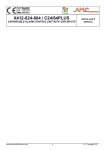

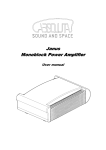
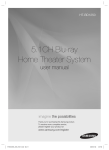


![[User manual] - KX_series_user_EN](http://vs1.manualzilla.com/store/data/005985322_1-73e2348e6003cbf1e0abe0da04f5dcec-150x150.png)
